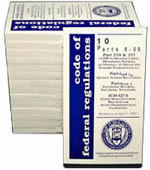The U.S. Nuclear Regulatory Commission and the Code of Federal Regulations
 Since working with ionizing radiation can present significant safety risks, its use is closely regulated. In the United States, the Nuclear Regulatory Commission (NRC) is responsible for protecting workers, the public and the environment from the effects of radiation. The NRC is an independent agency established by the Energy Reorganization Act of 1974 to regulate civilian use of nuclear materials. The NRC is headed by five commissioners appointed by the President and confirmed by the Senate for five-year terms.
Since working with ionizing radiation can present significant safety risks, its use is closely regulated. In the United States, the Nuclear Regulatory Commission (NRC) is responsible for protecting workers, the public and the environment from the effects of radiation. The NRC is an independent agency established by the Energy Reorganization Act of 1974 to regulate civilian use of nuclear materials. The NRC is headed by five commissioners appointed by the President and confirmed by the Senate for five-year terms.
The Code of Federal Regulations (CFR) is the system used by the US Federal Government to organize the rules published in the Federal Register by the executive departments and agencies. The CFR is divided into 50 titles that represent broad areas subject to Federal regulation. Title 10 of the code applies to energy and parts 0 through 50 of Title 10 apply to NRC rules. Part 19, Notices, instructions and reports to workers: inspection and investigations; Part 20, Standards for protection against radiation; and Part 34, Licenses for industrial radiography and radiation safety requirements for industrial radiographic operations, are areas of the Code that are of primary interest when addressing radiation safety in industrial radiography.
More than half of the states in the U.S. have entered into "agreement" with the NRC to assume regulatory control of radioactive material use within their borders. As part of the agreement process, the states must adopt and enforce regulations comparable to those found in Title 10 of the Code of Federal Regulations. Some of the requirement of the Code, such as exposure limits, responsibilities and procedures will be discussed in the following pages.